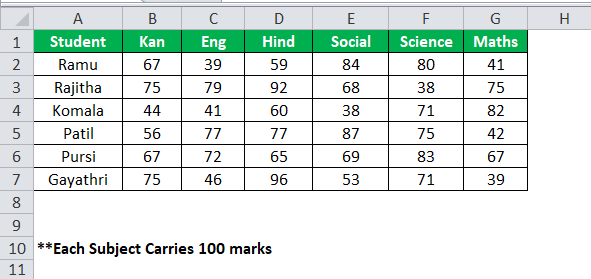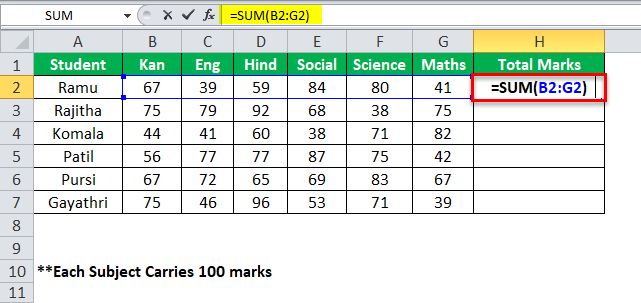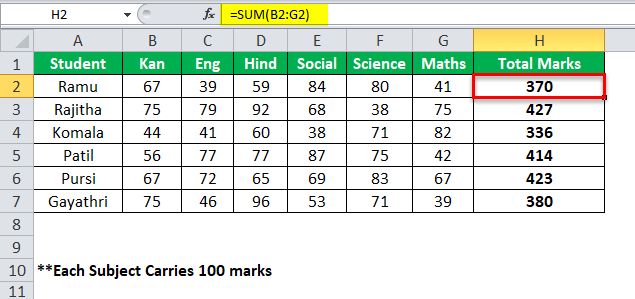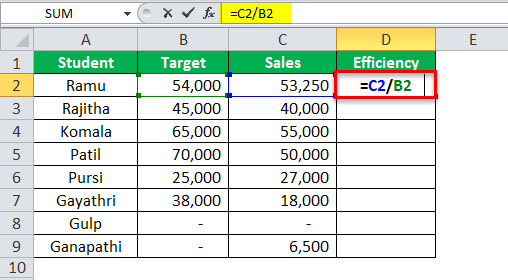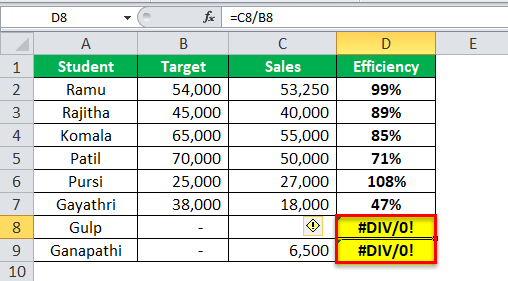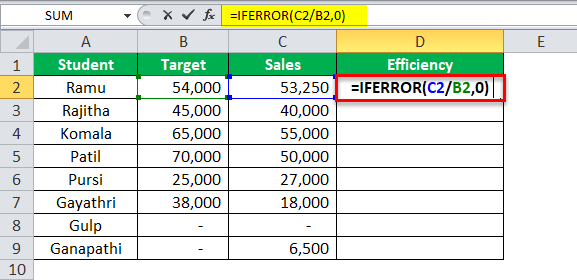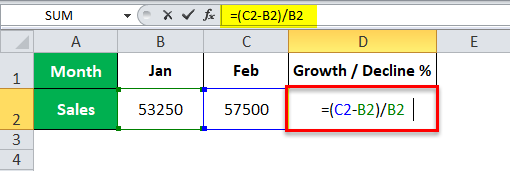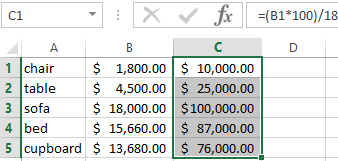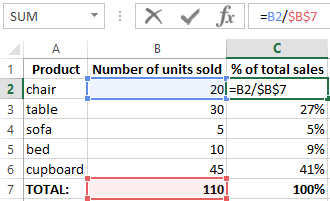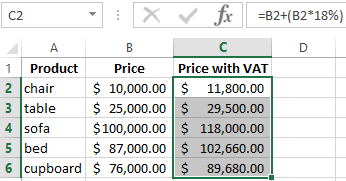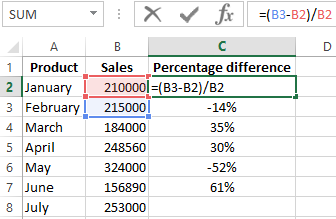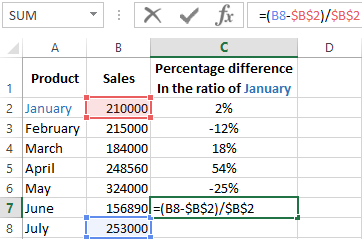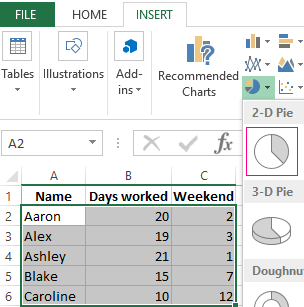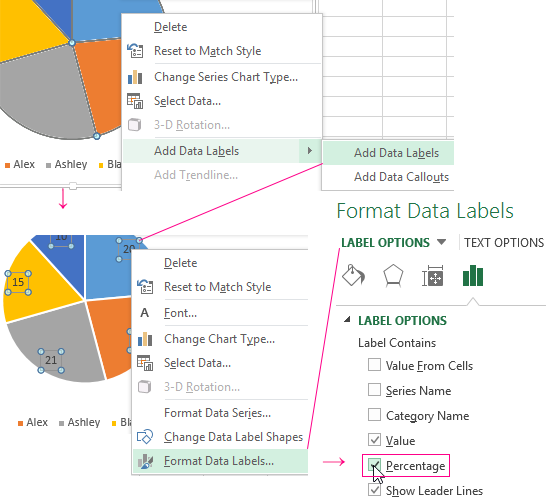Excel for Microsoft 365 Excel for Microsoft 365 for Mac Excel for the web Excel 2021 Excel 2021 for Mac Excel 2019 Excel 2019 for Mac Excel 2016 Excel 2016 for Mac Excel 2013 Excel 2010 Excel 2007 Excel for Mac 2011 More…Less
Sometimes percentages can be frustrating because it’s not always easy to remember what we learned about them in school. Let Excel do the work for you – simple formulas can help you find the percentage of a total, for example, or the percentage difference between two numbers.
Find the percentage of a total
Let’s say that you answered 42 questions out of 50 correctly on a test. What is the percentage of correct answers?
-
Click any blank cell.
-
Type =42/50, and then press RETURN .
The result is 0.84.
-
Select the cell that contains the result from step 2.
-
On the Home tab, click
.
The result is 84.00%, which is the percentage of correct answers on the test.
Note: To change the number of decimal places that appear in the result, click Increase Decimal
or Decrease Decimal
.
Find the percentage of change between two numbers
Let’s say that your earnings are $2,342 in November and $2,500 in December. What is the percentage of change in your earnings between these two months? Then, if your earnings are $2,425 in January, what is the percentage of change in your earnings between December and January? You can calculate the difference by subtracting your new earnings from your original earnings, and then dividing the result by your original earnings.
Calculate a percentage of increase
-
Click any blank cell.
-
Type =(2500-2342)/2342, and then press RETURN .
The result is 0.06746.
-
Select the cell that contains the result from step 2.
-
On the Home tab, click
.
The result is 6.75%, which is the percentage of increase in earnings.
Note: To change the number of decimal places that appear in the result, click Increase Decimal
or Decrease Decimal
.
Calculate a percentage of decrease
-
Click any blank cell.
-
Type =(2425-2500)/2500, and then press RETURN .
The result is -0.03000.
-
Select the cell that contains the result from step 2.
-
On the Home tab, click
.
The result is -3.00%, which is the percentage of decrease in earnings.
Note: To change the number of decimal places that appear in the result, click Increase Decimal
or Decrease Decimal
.
Find the total when you know the amount and percentage
Let’s say that the sale price of a shirt is $15, which is 25% off the original price. What is the original price? In this example, you want to find 75% of which number equals 15.
-
Click any blank cell.
-
Type =15/0.75, and then press RETURN .
The result is 20.
-
Select the cell that contains the result from step 2.
-
In newer versions:
On the Home tab, click
.
The result is $20.00, which is the original price of the shirt.
In Excel for Mac 2011:
On the Home tab, under Number, click Currency
The result is $20.00, which is the original price of the shirt.
Note: To change the number of decimal places that appear in the result, click Increase Decimal
or Decrease Decimal
.
Find an amount when you know the total and percentage
Let’s say that want to purchase a computer for $800 and must pay an additional 8.9% in sales tax. How much do you have to pay for the sales tax? In this example, you want to find 8.9% of 800.
-
Click any blank cell.
-
Type =800*0.089, and then press RETURN.
The result is 71.2.
-
Select the cell that contains the result from step 2.
-
In newer versions:
On the Home tab, click
.
In Excel for Mac 2011:
On the Home tab, under Number, click Currency
The result is $71.20, which is the sales tax amount for the computer.
Note: To change the number of decimal places that appear in the result, click Increase Decimal
or Decrease Decimal
.
Increase or decrease a number by a percentage
Let’s say that you spend an average of $113 on food each week, and you want to increase your weekly food expenditures by 25%. How much can you spend? Or, if you want to decrease your weekly food allowance of $113 by 25%, what is your new weekly allowance?
Increase a number by a percentage
-
Click any blank cell.
-
Type =113*(1+0.25), and then press RETURN .
The result is 141.25.
-
Select the cell that contains the result from step 2.
-
In newer versions:
On the Home tab, click
.
In Excel for Mac 2011:
On the Home tab, under Number, click Currency
The result is $141.25, which is a 25% increase in weekly food expenditures.
Note: To change the number of decimal places that appear in the result, click Increase Decimal
or Decrease Decimal
.
Decrease a number by a percentage
-
Click any blank cell.
-
Type =113*(1-0.25), and then press RETURN .
The result is 84.75.
-
Select the cell that contains the result from step 2.
-
In newer versions:
On the Home tab, click
.
In Excel for Mac 2011:
On the Home tab, under Number, click Currency
The result is $84.75, which is a 25% reduction in weekly food expenditures.
Note: To change the number of decimal places that appear in the result, click Increase Decimal
or Decrease Decimal
.
See also
PERCENTRANK function
Calculate a running total
Calculate an average
Need more help?
Want more options?
Explore subscription benefits, browse training courses, learn how to secure your device, and more.
Communities help you ask and answer questions, give feedback, and hear from experts with rich knowledge.
If you need to work with percentages, you’ll be happy to know that Excel has tools to make your life easier.
You can use Excel to calculate percentage increases or decreases to track your business results each month. Whether it’s rising costs or percentage sales changes from month to month, you want to keep on top of your key business figures. Excel can help you do that.
You’ll also learn how to work with advanced percentage calculations using the scenario of calculating grade point averages, as well as discover how to figure out percentile rankings, which are both relatable examples that you can apply to a variety of use cases.
In this tutorial, learn how to calculate percentages in Excel with step-by-step workflows. Let’s look at some Excel percentage formulas, functions, and tips using a sheet of business expenses and a sheet of school grades.
You’ll walk away with the techniques needed to work proficiently with percentages in Excel.
Screencast
Watch the complete tutorial screencast, or work through the step-by-step written version below. First, download the source files for free: Excel percentages worksheets. We’ll use them to work through the tutorial exercises.
1. Input
Initial Data in Excel
Input the data as follows (or start with the download file
«percentages.xlsx» contained in the tutorial source files). This worksheet is for Expenses. Later in this tutorial, we’ll
use the Grades worksheet.
2. Calculate a Percentage Increase
Let’s say you anticipate that next year’s costs will be 8%
higher, so you want to see what they are.
Before writing any formulas, it’s helpful to know that Excel
is flexible enough to calculate the same way whether you type percentages with
a percent sign (like 20%) or as a decimal (like 0.2 or just .2). To Excel, the
percent symbol is just formatting.
We want to show the total estimated amount, not just the increase.
Step 1
In A18, type the
header With 8% increase. Since we
have a number mixed with text, Excel will treat the entire cell as text.
Step 2
Press Tab, then
in B18, enter this Excel percentage formula: =B17 * 1.08
Alternatively, you can enter the formula this way: =B17 * 108%
The amount is 71,675, as shown below:
3. Calculate a Percentage Decrease
Maybe you think your expenses will decrease by 8 percent
instead. To see those numbers, the formula is similar. Start by showing the
total, lower amount, not just the decrease.
Step 1
In A19, type the
header With 8% decrease.
Step 2
Press Tab, then
in B19, enter this percentage formula in Excel: =B17 * .92
Alternatively, you can enter the formula this way: =B17 * 92%
The amount is 61,057.
Step 3
If you want a little more flexibility in changing the
percentage by which you think the costs will rise or drop, you can enter the
formulas this way, instead:
For the 8% increase, enter this formula in B18: =B17 + B17 * 0.08
Step 4
For the 8% decrease, enter this Excel percentage formula in B19: =B17 – B17 * 0.08
With these formulas, you can simply change the .08 to
another number to get a new result from a different percentage.
4. Calculate a Percentage Amount
Now to work through an Excel formula for a percentage amount. What if you want to see the 8% amount itself, not the new total? To do that, multiply the total
amount in B17 by 8 percent.
Step 1
In A20, enter the header 8% of total.
Step 2
Press Tab, then
in B20 enter the formula: =B17 * 0.08
Alternatively, you can enter the formula this way: =B17 * 8%
The amount is 5,309.
5. Make Adjustments Without Rewriting Formulas
If you want to change the percentage without having to
rewrite the formulas, put the percentage in its own cell. We’ll start by
entering row titles.
Step 1
In A22, type Adjustment.
Press Enter.
Step 2
In A23, type Higher
total. Press Enter.
Step 3
In A24, type Lower
total. Press Enter.
The worksheet should now look like this:
Now enter the percentage and the formulas to the right of
the titles.
Step 4
In B22, type 8%. Press Enter.
Step 5
In B23, enter
this formula to give you the total plus another 8%: =B17 + B17 * B22
Step 6
In B24, enter this
formula to give you the total less 8%: =B17 * (100% - B22)
When you type the 8% in B22, Excel automatically formats the
cell as a percentage. If you type .08 or 0.08, Excel will leave it like that.
You can always format it as a percent later on by clicking the Percent Style
button on the Ribbon:
Tip: you can also format the numbers as Percent Style using
a keyboard shortcut: press Control—Shift—% in Windows or Command-Shift-% on the Mac.
6. Calculate a Percentage Change
You might also want to calculate the percentage change from
one month to the next month. That would give you a picture of whether costs
were heading up or heading down. So let’s do that down column C.
The general rule to calculate a percentage change is:
=(new value — old
value) / new value
Since January is the first month, it doesn’t have a
percentage change. The first change will be from January to February, and we’ll
put this next to February’s number.
Step 1
To calculate the first percentage change, enter this percent change formula in C5: =(B5-B4)/B5
Step 2
Excel displays this as a decimal, so click the Percent Style
button on the Ribbon (or use the above mentioned shortcuts) to format it as a
percent.
Now that we know what the percent change is from January to
February, we can AutoFill the formula down column C to show the remaining percent
changes for the year.
Step 3
Roll the mouse pointer over the dot in the lower-right
corner of the cell that shows -7%.
Step 4
When the mouse pointer becomes a crosshair, Double-click.
If you’re unfamiliar with the AutoFill feature, see technique 3 in my Excel power techniques article:
Step 5
Click cell B3
(the “Amount” header).
Step 6
Put the mouse pointer on its AutoFill dot and drag one cell to
the right, into C3. That duplicates the
header, including the formatting.
Step 7
In C3, type % Change, replacing the text that’s already
there.
7. Calculate a Percentage of Total
The final technique on this sheet is to find the percent of
total for each month. For a percent of total calculation, think of a pie chart
where each month is a slice, and all the slices add up to 100%.
Whether with Excel or with pencil and paper, the way to
calculate a percentage of total is with a simple division:
Component
number/total
… and format it as a percentage.
In this example, we divide each month by the total at the
bottom of column B.
Step 1
Click on C3 and
AutoFill one cell across to D3.
Step 2
Change D3 to % of Total.
Step 3
In D4, type this
formula, but don’t press Enter, yet: =B4/B17
Step 4
Before entering the formula, we want to be sure of preventing
AutoFill errors. Since we’re going to AutoFill down the column, the denominator,
which is now B17, shouldn’t change. If it does, the numbers for February
through December will be wrong.
Make sure the text cursor is still in the formula, on the “B17”
denominator.
Step 5
Press the F4 key
(on the Mac, press Fn—F4).
That inserts dollar signs before the column and the row, turning
the denominator into $B$17. The $B means that column B won’t increase to column
C, etc. and the $17 means the row won’t increase to $18, etc.
Step 6
Make sure the percentage formula in excel is now: =B4/$B$17.
Step 7
Now we can enter and AutoFill.
Press Control-Enter (on the Mac, press Command-↩)
to enter the formula without moving the cursor down to the next row.
Step 8
Click the Percent
Style button on the ribbon or use the Control-Shift-% (Command-Shift-%) shortcut.
Step 9
Roll the mouse pointer over the AutoFill dot in the
lower-right corner of D4.
Step 10
When the cursor becomes a crosshair, double-click to
AutoFill the formula down to the bottom.
Each month will now show how much of a percentage of the
grand total it is.
8. Percentage Ranking
Ranking numbers by percent is a statistical technique.
You’re probably familiar with it from school: you and your classmates have
grade point averages, so each of you is ranked in a percentile. The higher your
grades, the higher your percentile.
The list of numbers (grades, in this
example) are in a range of cells that Excel calls an array. There’s nothing
special about an array and you don’t have to define it. That’s just what Excel
calls the range of cells you plug into a formula.
Excel has two functions for percentage ranking. One function
includes the beginning and ending numbers of the array and the other function
doesn’t.
Look at the second tab in the worksheet: Grades.
This shows a list of 35 grade point averages, sorted in
ascending order. The first thing we want to do is find the percentile rank for
each one. To do this, we’ll use the =PERCENTRANK.INC function. The “INC” part
of that function means “inclusive,» as it will include the first and last grades
in the list. If you want to exclude the first and last numbers in the array,
you would use the =PERCENTRANK.EXC function.
The function takes two mandatory arguments and the syntax
is: =PERCENTRANK.INC(array,
entry)
-
array is the
range of cells that contains the list (in this example, it’s B3:B37) -
entry is any
number or cell in the list
Step 1
Click C3, the
first one in the list.
Step 2
Start typing this formula, but don’t press Enter, yet: =PERCENTRANK.INC(B3:B37
Step 3
This range needs to be an absolute reference so we can
AutoFill to the bottom.
Press F4 (on the
Mac, press Fn—F4) to insert dollar signs.
The formula should now look like this: =PERCENTRANK.INC($B$3:$B$37
Step 4
In each case down column C, we want to know the percent rank
of the entry in column B.
Click B3, then
close the parenthesis.
The formula is now
this: =PERCENTRANK.INC($B$3:$B$37,B3)
Now we can fill in and format the numbers.
Step 5
If necessary, click back on C3 to select it.
Step 6
Double-click the AutoFill dot on C3. That automatically fills down the column.
Step 7
On the Ribbon, click the Percent Style button to format the
column as percentages. You should now see the finished result:
So if you had very good grades and your GPA was 3.98, you
would say that you ranked in the 94th percentile.
9. Finding the Percentile
You can also find the percentile directly, using the PERCENTILE
functions. With these functions, you enter a percent rank, and it will return a
number from the array that corresponds to that rank. If the exact number you
want isn’t listed, Excel will interpolate the result and return the number that
“should” be there.
When would you use this? Let’s say you plan on applying for
a graduate program, and the program accepts only students who score in the 60th percentile or higher. So you want to know what GPA is exactly 60%. Looking at
this list, we can see 3.22 is at 59% and 3.25 is at 62%, so we can use the
=PERCENTILE.INC function to find the answer.
The syntax is: =PERCENTILE.INC(array,
percent rank)
-
array is the
range of cells that contains the list (same as the previous example, B3:B37) -
rank is a
percentage (or a decimal between and including 0 and 1)
Just like with the percent ranking functions, you could use =PERCENTILE.EXC
to exclude the first and last entries in the array, but that’s not what we want
in this example.
Step 1
Click in B39,
below the list.
Step 2
Enter this formula: =PERCENTILE.INC(B3:B37,60%)
Since we aren’t going to AutoFill this formula, there is no
need to make the array an absolute reference.
Step 3
On the Ribbon, click the Decrease Decimal button once, to round the number to two decimal
places.
The result is that in this array, a 3.23 GPA is the 60th percentile. Now you know the grades you need for acceptance into the program.
Conclusion
Percentages aren’t complicated, and Excel calculates them
using the same rules of math as you would use with pencil and paper. Excel also
adheres to the standard order of operations when you have addition, subtraction, and multiplication in a formula:
- Parentheses
- Exponents
- Multiplication
- Division
- Addition
- Subtraction
I always remember this with the mnemonic Please Excuse My Dear Aunt Sally.
Did you find this post useful?
Bob Flisser has authored many videos and books about Microsoft and Adobe products, and has been a computer trainer since the 1980s. He is also a web and multimedia developer. Bob is a graduate of The George Washington University with a degree in financial economics.
How to Calculate Percentage Using Excel Formulas?
The percentage is calculated as the proportion per hundred. In other words, the numerator is divided by the denominator and the result is multiplied by 100. The percentage formula in Excel is = Numerator/Denominator (used without multiplication by 100). To convert the output to a percentage, either press “Ctrl+Shift+%” or click “%” on the Home tab’s “number” group.
Let us consider a simple example.
On a 15-day vacation, Mr. A spent 10 days in his hometown and 5 days in the USA. What percentage of days did he spend in the USA?
The calculations are given as follows:
- Percentage formula=Portion days/Total days*100
- Percentage of days spent in the USA=5/15*100=33.33%
- Percentage of days spent in hometown=10/15*100=66.66%
Hence, Mr. A spent approximately 33% of his vacation period in the USA.
Table of contents
- How to Calculate Percentage Using Excel Formulas?
- Example #1
- Example #2
- Example #3
- Frequently Asked Questions
- Recommended Articles
You can download this Formula for Percentage Excel Template here – Formula for Percentage Excel Template
Let us go through the following examples to understand the concept of percentage in Excel.
Example #1
The following table shows the subject-wise marks of 6 students in a school. Since the results pertain to the annual examinations, the maximum marks of every subject are 100.
We have to calculate the percentage of marks for all students.
The steps to calculate percentages in Excel are listed as follows:
- Calculate the total marks obtained by the students. For this, the marks of every subject are added.
- Drag the formula of cell H2 to get the total marks obtained by all students. The output is shown in the following image.
- Divide the total marks by 600. The values of the “total marks” column become the numerator. Since the number of subjects is 6, the maximum marks are 600 (100*6=600). This becomes the denominator.
- Apply the following formula.
Percentage=Marks scored/Total marks*100.
For percentage values (shown in the succeeding image), change the cell formatting. Select column I and press “Ctrl+Shift+%.” Alternatively, select “%” in the “number” group of the Home tab.
Example #2
The following table consists of students who undertake internship in an organization. Their task is to sell products based on pre-defined targets.
We want to determine the efficiency level (percentage) of every student.
The steps to calculate the efficiency level are listed as follows:
Step 1: Apply the formula “sales/target.”
Step 2: Format column D to obtain the efficiency levels in percentage. For the last two students (Gulp and Ganapathi), the formula returns “#DIV/0!” errorErrors in excel are common and often occur at times of applying formulas. The list of nine most common excel errors are — #DIV/0, #N/A, #NAME?, #NULL!, #NUM!, #REF!, #VALUE!, #####, Circular Reference.read more.
Note: If the numerator is zero, the division of the numerator by the denominator returns “#DIV/0!#DIV/0! is the division error in Excel which occurs every time a number is divided by zero. Simply put, we get this error when we divide any number by an empty or zero-value cell.read more” error.
Step 3: To eliminate the error, tweak the existing formula as “=IFERROR(C2/B2,0).” This implies that the IFERROR The IFERROR function in Excel checks a formula (or a cell) for errors and returns a specified value in place of the error.read moredisplays zero if the division of C2 by B2 returns an error.
In other words, the “#DIV/0!” error is replaced by zero with the help of the modified formula.
Note: The IFERROR functionThe IFERROR function in Excel is used to determine what to do when an error occurs before performing any function.read more helps get rid of percentage errors.
Step 4: The output using the IFERROR function is shown in the following image. The efficiency levels of students Gulp and Ganapathi are zero. This is because of the blank (zero) in column B and/or column C.
Example #3
For 2018, an organization’s sales for the months January and February are given in the following table.
We want to calculate the growth or the decline (percentage) in monthly sales.
The steps to calculate the increase (growth) or decrease (decline) percentage are listed as follows:
Step 1: Apply the formula “=(C2-B2)/B2.”
The sales in February (57500) are more than the sales in January (53250). The difference (growth) between the two sales is divided by the sales of the initial month (January).
Step 2: Format column D to obtain the growth percentage.
Hence, the February sales have increased by 7.98% over January sales.
Note: While calculating the growth or decline percentage, if the numerator or the denominator is less than zero, the output is a negative value.
Frequently Asked Questions
1. What is the Excel formula for percentage?
The basic percentage formula is “(part/total)*100”. This formula is used in Excel without the latter part (*100). This is because when the percentage format is selected, the resulting number is automatically changed to percent.
In addition, the decimal points are removed and the output is shown as a rounded percentage. For instance, 26/45 is 0.5777. By applying the percentage format, this decimal number becomes 58%.
To convert the output to percentage, either press “Ctrl+Shift+%” or select “%” in the “number” group of the Home tab.
2. What is the Excel formula for calculating the percentage change?
The formula for calculating the percentage change is stated as follows:
“(New value-Initial value)/Initial value”
This formula helps calculate the percentage increase or decrease between two values. A positive percentage implies an increase, while a negative percentage shows a decrease.
Note: To get the final answer (percentage change), the percentage format is applied to the output of the formula.
3. What is the Excel formula for calculating the percentage of the total?
The formula for calculating the percentage of the total is “(part/total).” For instance, column A lists the monthly expenses from cell A2 to cell A11. The cell A2 contains $2500 as the rent paid. The cell A12 contains the total expenses $98700.
The formula “=A2/$A12” returns 3% after applying the percentage format. This implies that the rent is 3% of the total paid expenses.
Since A2 should change on dragging the formula to the remaining cells, it is entered as a relative reference. On the other hand, the total should remain fixed for all cells, so A12 is entered as an absolute reference.
- The percentage is the proportion per hundred.
- To calculate the percentage, the numerator is divided by the denominator and the result is multiplied by 100.
- For obtaining percentages, the output column is formatted by pressing “Ctrl+Shift+%” or selecting “%” in the Home tab.
- The division of the numerator by the denominator returns “#DIV/0!” error if the former is zero.
- The percentage errors can be removed with the help of the IFERROR function.
- The increase or decrease percentage is calculated by dividing the difference between two numbers with the initial number.
Recommended Articles
This has been a guide to formula for percentage in Excel. Here we discuss the calculation of Excel percentages using the IFERROR formula along with Excel examples and downloadable Excel templates. You may also look at these useful functions in Excel –
- Percentage Change Formula
- Percentage Profit Formula
- Calculate the Percentage Increase in Excel
- Percentage Difference in Excel
In various activities it is necessary to calculate percentages. We should understand, how do we «get» them. Trade allowances, VAT, discounts, profitability of deposits, securities and even tips — all these are calculated in the form of some part from the whole.
Let’s figure out how to work with the percentages in Excel. This program calculates automatically and admits different variants of the same formula.
Working with percentages in Excel
To count the percentage of the number, add, and take percentages on a modern calculator is not difficult. The main condition is the corresponding icon (%) on the keyboard. And only then it’s the matter of technology and mindfulness.
For example 25 + 5%. To find the value of the expression, you need to type on the calculator a given sequence of numbers and signs. The result is 26.25. With such a technique the great intellect is not needed.
To formulate formulas in Excel, let us recollect the school basics:
Percentage is one hundredth part of the whole.
To find a percentage of an integer, we should divide the required fraction by an integer and multiply by 100.
Example: 30 pieces of goods were bought. On the first day 5 units were sold. How many percentages of goods were sold?
5 is a part. 30 is an integer. We substitute data into the formula:
(5/30) * 100 = 16.7%
To add a percentage to a number in Excel (25 + 5%), you must first find 5% of 25. At school there was the proportion:
- 25 — 100%;
- Х — 5%.
X = (25 * 5) / 100 = 1.25
After that you can perform the addition. When the basic computing skills are restored, it is easy to understand the formulas.
How to calculate the percentage from the number in Excel
There are several ways.
Adapt the mathematical formula to the program: (Part / Whole) * 100.
Look attentively at the formula line and the result. The result turned out to be correct. But we did not multiply by 100. Why?
In Excel the format of the cells changes. For C1, we have assigned a «Percentage» format. It means multiplying the value by 100 and putting it on the screen with the sign %. If necessary, you can set a certain number of digits after the decimal point.
Now let’s calculate how much will be 5% of 25. To do this, enter the formula in the cell: = (25 * 5) / 100. The result is:
Another variant is = (25/100) * 5. The result will be the same.
Let’s have the example in another way by using the % sign on the keyboard:
Let us apply this knowledge to practice.
The cost of the goods and the VAT rate (18%) are known. We need to calculate the amount of VAT.
We multiply the cost of goods by 18%. Copy the formula for the whole column. To do this, we catch the mouse with the lower right corner of the cell and pull it down.
The amount of VAT, the rate is known. We should find the value of the goods. Calculation formula is: = (B1 * 100) / 18. The result is:
The quantity of the sold goods is known, separately and the whole. It is necessary to find the share of sales for each unit relative to the whole. The calculation formula remains the same: Part / Whole * 100. Only in this example we make the reference to the cell in the denominator of the fraction absolute. Use the $ sign in front of the line name and column name: $B$7.
How to add the percent to number
The task is solved in two actions:
- Firstly, we find how much a percentage of the number is. Here we calculated how much will be 5% of 25.
- Secondly, we add the result to the number. Example for review: 25 + 5%.
And here we performed the actual addition. Omit the intermediate effect.
The VAT rate is 18%. We need to find the amount of VAT and add it to the price of the goods. The formula is: =price + (price * 18%).
Do not forget about the brackets! With the help of it we establish the calculation procedure.
To remove the percentage from a number in Excel, you should follow the same procedure. We perform subtraction instead of addition.
How to count the odds in percentage in Excel?
What is the amount of the value changing between the two values in percentage?
First, let’s abstract from Excel. A month ago, the tables were brought to the store at a price of 100$ per unit. Today, the purchase price is 150$.
Difference in percentage is: = (New price – Old price) / Old price * 100%.
In our example, the purchase price for a unit of goods increased in 50%.
Let’s calculate the percentage difference between the data in two columns:
Do not forget to expose the «Percentage» format of the cells. Calculate the percentage difference between the lines:
The formula is as follows: =(next value – previous value) / previous value.
With such an arrangement of the data, the first line is skipped!
If you want to compare the data for all months with January, for example, use the absolute reference to the cell with the desired value ($ sign).
How to make a diagram with percentages
The first option is to make a column in the data table. Select 2 cell ranges A2:A6 and C2:C6 (while holding down the CTRL key). Then use this data to build a chart. Select the cells with percentages and copy — click «INSERT» — select the type of chart (for example «2D Pie») — OK.
The second option: specify the format of data signatures in the form of a share. There are 22 working shifts in May. You need to calculate the percentage: the amount of work each worker did. We compose the table, where the first column is the number of working days; the second is the number of days off.
We make a pie chart. Select the data in cell ranges A2:C6. «INSERT» — «Insert Pie or Doughnut Chart» — «2D Pie».
Click on them with the right mouse button — «Add Data Labels» and «Format Data Labels»:
Choose «Share». On the tab «LABEL OPTIONS» we choose the percentage format. It turns out like this:
Download examples Calculate Percentages in Excel
We may stop here. And you can edit it to your taste: change the color, the appearance of the diagram, makes underscores and so on.
How to Make A Percentage Formula in Excel: Step-by-Step
We use percentages almost everywhere. For example, there’s a 50% off this weekend, monthly sales have risen by 30%, you get an annual increment of 15%, etc.
The percentage is a genius concept, and the best part – they are super easy to calculate.
This guide will help you explore a few ways to calculate and present percentages in Excel. And you’d enjoy it to the core.
Download our free sample workbook here to tag along with the guide as you continue reading.
Formula for percentage
Back to grade 4 arithmetic, here’s the formula for calculating a basic percentage.
= Value / Total Value * 100
For example, to see what percentage is 30 out of 200, you write it as shown below.
= 30 / 200 * 100
And that’s 15%.
In Microsoft Excel, there is no in-built function for calculating percentages. To reach a percentage in Excel, you need to put together the following formula
= Value / Total Value
And then format it as a percentage.
The only difference between a normal percentage formula and the Excel formula is ‘100’.
Let’s see a quick example of how this works.🙈
1. Here’s an image of the total and secured marks for some students.

Calculate the percentage marks secured by each student.
2. Activate a cell and format it as a percentage by going to Home > Number > Formats > Percentage.

4. In the same cell, now write the percentage formula as below.
= B2 / C2
Don’t forget, always start a formula with an equal sign (=) 😊

Cell B2 contains the value (the secured marks,) and Cell C2 contains the total value (the total marks).
5. Hit ‘Enter’.

Wow! Kevin scored a whopping 88%.✌
6. Drag and drop the same to all the students to calculate percentages for all.

Percentage increase in Excel
Most of the time you’d want to use Excel to calculate the percentage change between two values.
The increase or decrease percentage is calculated by dividing the difference between two numbers by the initial number (the base value).
Calculating percentage increases in Excel is super easy – see for yourself.
1. The data below shows the share prices of some companies over two years.

All the companies show an increase in the share price over the year. But what percent increase is this?
2. To calculate it, write the percentage increase formula shown below:
= (New Share Price – Old Share Price) / Old Share Price
= (C3 – B3) / B3

The above formula gives the change in share price as a percentage of the old share price.
Note the parenthesis to the subtraction function. Adding parenthesis tells Excel to perform subtraction first and the division operation last.
3. Hit ‘Enter’ and drag and drop to have the results, as below.

The shares of Company A show a percentage increase of 12%. This means the share price has increased by 12% since the last year.
If the share prices had declined over the year, the same formula would have been used to calculate the percentage decrease instead.
Showing decimals as percentages
Continuing the same example as above.
Did you see the same upon applying the percentage formula in Excel?

We applied the formula for percentage increase but all that we get is a decimal number.
Don’t fret. This is only because the ‘percentage’ format is yet not applied to the subject cell.
1. Select the cells where the decimals appear.
2. Go to Home > Number > Formats > Percentage.

You may use the shortcut to apply the percentage format by going to the Home tab > Numbers > the percentage Icon.
3. Excel changes the decimal to a percentage.

4. Maybe this percentage is not an exact round number. In most cases, percentages with zero decimal positions are rounded up / down by Excel.
5. To add decimal positions to your percentage, select the cell.
6. Go to Home > Number > Formats > More Number Formats.

7. This launches the ‘Format Cells’ Dialog box as below.
8. Go to Percentage format from the “Format Cells” dialog box.

9. Set the decimal positions to any desired number.

10. Excel adds specified decimal positions to the percentage values, as shown below.

Pro Tip!
You can also increase or decrease the decimal positions to a percentage by using the shortcut below.
Go to Home > Number > Decimal Increase / Decrease button
That’s it – Now what?
That’s all about how to calculate percentages in Excel.
Very simple but very useful. You’d need percentage calculation almost everywhere. And Excel can help you fast-forward your percentage calculations.
This guide explains how you can calculate percentage change and simple percentages in Excel. It also discusses different ways how you may format and present percentages in Excel. (With many tips to help you save time and hassle).🙌
Calculating percentages in Excel will appreciably help you. However, use it in combination with other major functions of Excel to make the best use of it.
These functions include the VLOOKUP, SUMIF, and IF functions of Excel. My 30-minute free email course takes you through these and many more functions of Excel. Sign up now.
Kasper Langmann2022-11-14T20:49:09+00:00
Page load link

 .
. or Decrease Decimal
or Decrease Decimal  .
. .
.















































